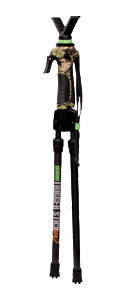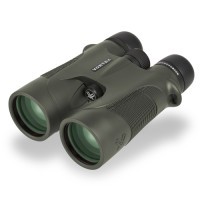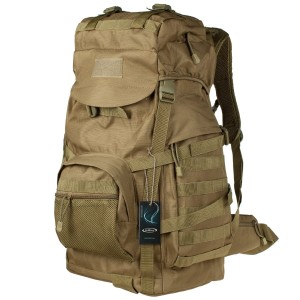May, 2016: The following list of items is what Frontiers considers to be a necessity to enjoy a stag hunt in Argentina to the fullest, and we suggest not leaving home without them.
Mandatory Gear:
Great binoculars are a must, and a spotting scope and tripod is a good bet too. 10 X 40 is recommended by the outfitter. They provide plenty of clear detail and work well in low light conditions. Without them, you are at a definite disadvantage. Much of your time is spent selecting which animal you will choose to stalk, and a lot of precious time and energy will be wasted if you don’t have the ability to distinguish differences.
Camouflage Clothing:
Muted tan and olive drab colors in varying fabric weights work well on the ranch. You don’t need anything elaborate, but breathable materials will allow you to be comfortable in a variety of situations.

Primos Hunting Short Bi Pod
Shooting Sticks:
If you practice with sticks, it’s a good idea to bring them along. There are plenty of rocks/boulders on the property, but you never know where or when your shot may occur. Having easy access will come in handy to deliver the best shot possible.
Shooting Gloves and Hunting Pants:
Crawling over rocks and thorns on your hands and knees (and even belly crawling) are often times required in order to get within range in open terrain. Hunting pants with removable kneepads and shooting gloves with padded backsides are a must to enjoy your hunt. At the very minimum, bring a pair of slip-on soft-sided kneepads, available at most hardware stores. Sitka and Kryptek make pants with removable kneepads that are quite convenient.
Hunting Boots:
While the majority of the terrain at the ranch is mild to moderate by Rocky Mountain standards, you’ll put on a lot of miles. There is a tremendous amount of rocks, grass hummocks, and “loose- footing” soil areas to navigate through. A well-broken-in boot with good ankle support is a must. Make sure it is properly-fitted, lightweight, and uninsulated.
Small to Mid-Sized Day Pack:
You may recall from my previous blog that horseback is the preferred method of hunting. The pack should be large enough to carry raingear and smaller necessities like water bottles, kneepads, gloves, etc. You typically carry your rifle/bow on your back so have a strategy in mind when considering the proper pack.
Proper Headwear:
In addition to a hat, a Buff or Hoorag brand headwear in camo or drab colors helps keep the sun off your face/neck/ ears and minimizes the use of smelly sunscreens. It can get hot at the ranch and the sun can be punishing. I’m talking low 80’s, so be prepared. You need sun protection of some sort even if it’s sunscreen.
First Aid Kit:
A compact First Aid Kit complete with alcohol swabs, Band-Aids, antibiotic ointment, ibuprofen, and moleskin can keep you going in the field. Your guide will have one at all times, but a small kit can be used for personal fixes or hotspots in your own room.
Water Bottle:
Bottled water is provided, but sometimes bottles can leak and create noise in your pack.
Duct Tape:
A small roll of duct tape is always a good idea and can aid in making simple field repairs. Making several wraps of tape around a re-usable water bottle saves space and weight.
Pre-Trip Preparations / Expectations:
- Be realistic. It’s very unwise to book a hunt on which a lot will be asked of you physically if you’re over 40, overweight, and work a desk job. If you do decide to book a hunt, you’ll need a minimum of two months to prepare before you can manage it.
- Get healthier first and see a doctor find out what your heart can handle. Your physician will give you a stress test, which means you walk on a treadmill with electrodes pasted all over your body. Stress tests are not a 100 percent guarantee that your ticker is okay. Short of cutting your chest open to take a look, it’s the best option.
- Lose weight, if necessary. Lose all the weight you possibly can. If you can get to the point where people burst into tears when they see you, you’ve done well.
- Exercise, but don’t jog. Jogging will get your heart and lungs in superb shape even as it destroys your feet, knees, hips, and lower back. Low impact exercise such as riding a bike or climbing the stairs is recommended because the leg lifting and pushing involved will actually do a much better job of conditioning you for hunting than jogging. Exercise your stomach and lower back because you’ll probably be lifting duffel bags and (if you’re lucky) dead animals and a wrenched back in the boondocks is big trouble. Lifting weights is fine, but warm up first. Don’t get crazy about it or you’ll risk tearing tendons. What you’re after is the ability to work pretty hard for a long period of time, so focus on endurance above all.
- Don’t be a hero. Have a heart-to-heart (pun intended) talk with your outfitter/guide. Remind him that dead men leave no tips so don’t put yourself in a situation where you’ll tempt the reaper. Don’t load yourself down with equipment because you’ll suffer for every unneeded ounce you carry. Like Clint Eastwood says “a man needs to know his limitations.”
When it comes to setting a pace, you can’t be expected to run up mountains, but you are going to have to climb those mountains steadily, or else you may go home empty-handed. A hunter who has to stop and gasp for breath every few minutes will get no sympathy from anyone. I ask: “Why do I kill myself like this?” And the answer is: “So I don’t kill myself.”
By: Tom Gilliland






